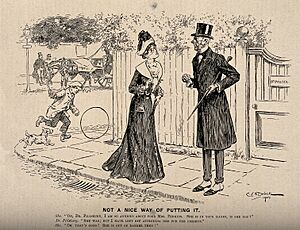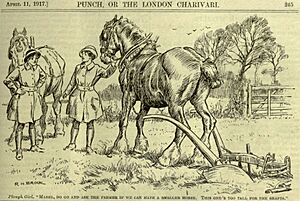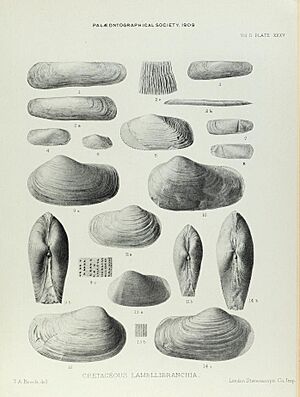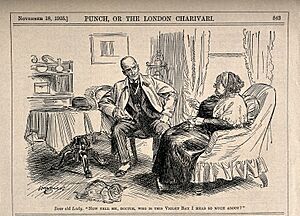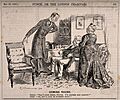The Brocks of Cambridge facts for kids
The Brocks were a family of talented artists from Cambridge, England. They were active during the late Victorian era, the Edwardian period, and the time between the two World Wars. There were four brothers and three sisters in the family.
The four brothers were professional painters and illustrators. Two of them, Charles Edmund and Henry Matthew, became very famous for their illustrations in classic English books, especially those by Jane Austen. One brother even earned a special degree in Mathematics, which was a big achievement for someone from their background at that time.
The three sisters were not as well-known, which was common for women artists back then. However, at least one sister was a skilled artist and poet. The family's biographer, Clifford Michael Kelly, found that all the siblings worked together and supported each other, even though some were more famous than others.
Contents
The Brock Parents
The father, Edmund Brock (1840–1921), started out as a bootmaker. He was very smart and later became a reader (like a proofreader or editor) for Cambridge University Press. He worked on old English and other languages. He translated and edited important medieval texts like The Grammatical Forms of Southern English and Morte Arthure.
Edmund married Mary Ann Louise Pegram (1835–1912). Her family was also very artistic. Her father was a photographer, and her nephews included famous sculptors like Henry Alfred Pegram and Fred Pegram, who was also an illustrator.
Education and Learning
The Brock children first went to St Barnabas Church of England infant and junior school. The boys then attended the Boys Higher Grade School in Cambridge, which was known for its good science classes. The Brock boys often won prizes there. The headmaster even said that the Brocks made the school famous!
The girls went to the Girl's Higher Grade school. All the Brock children also studied art at the Cambridge School of Art. They were also very musical, playing instruments or singing, and often had musical evenings together. They frequently performed at concerts for good causes, especially for their church.
Art Training at Cambridge School of Art
The Brocks mainly learned their art skills at the Cambridge School of Art. This school, which started in 1858, is now part of Anglia Ruskin University.
At least five of the Brock siblings attended the school and won many awards. Charles even became a teacher there, and Richard was a pupil-teacher. The school was connected to the Government's Science and Art Department, which promoted art education and gave out national prizes and scholarships.
The Brocks won many awards. For example, Charles won Bronze Medals for painting heads from life, and Richard won prizes for landscape painting and design. Henry received "Free Studentships," meaning his studies were paid for. Katharine also won prizes for her work in evening classes and studies of flowers.
Family Faith and Politics
The entire Brock family was very involved with the St. Andrew's Street Baptist Chapel. They helped raise money for a new church building in 1903. Bertha and Katharine ran stalls at a bazaar, while the brothers performed in concerts. Katharine was even the president of the Girls Guild at the church.
In politics, the family supported the Liberal Party. Charles helped nominate the Liberal candidate in the 1906 election. Edmund and three of his sons attended Liberal Party meetings. The brothers were also members of the Liberal Club in Cambridge.
The Family Home and Studio
The Brock family moved several times before settling at Arundine House in Cambridge around 1898. This large, three-story house became their home for the next seventy years.
Behind Arundine House, the Brocks built a huge studio. This studio was very important because all four brothers worked there together. It had a special "north-light" window, which is great for artists because it provides steady, even light.
The studio also held a collection of old costumes and furniture. Charles and Henry used these to make sure their illustrations, especially for authors like Jane Austen, were historically accurate. They even had clothes specially made for their models to match different time periods. Their knowledge of antiques also led them to illustrate a book on furniture history.
The Cranford Art Style
The "Cranford School" of illustration wasn't a real school, but a style of art. It got its name from the illustrations in Elizabeth Gaskell's book Cranford by Hugh Thomson. This style was known for being "nostalgic" and "whimsical," looking back at old English life before factories and industry changed everything.
Charles and Henry Brock were both part of this "Cranford School." In fact, Charles even named his house "Cranford." Their cousin, Fred Pegram, was also a member of this style.
The Brock Children
Alice Emma (1868–1896)
Alice Emma Brock was the oldest of the Brock children. She was born in London in 1868. Sadly, she was the shortest-lived, dying at just twenty-eight years old in Great Yarmouth. Her brother Thomas was with her when she passed away.
Charles Edmund (1870–1938)
Charles Edmund Brock was the oldest and most successful of the Brock brothers. Born in London in 1870, he attended the same schools as his brothers and excelled at the Cambridge School of Art, winning many prizes.
Charles received some art training from sculptor Henry Wiles, a neighbor. He married Annie Dudley Smith in 1902 and they lived in a house called Cranford in Cambridge. They did not have children.
Charles illustrated nearly 270 books, including a 30-volume set of Thackeray's works. He also drew for magazines and painted portraits of important people in Cambridge. He contributed 109 illustrations to Punch magazine between 1901 and 1910. Charles died in 1938.
Richard Henry (1871–1943)
Richard Henry "Dick" Brock was born in London in 1871. He also attended St Barnabas and the Higher Grade Boys' School, where he was a science scholar. He won many national prizes at the Cambridge School of Art and even taught there until 1895.
For about 20 years, Richard focused on painting landscapes, especially cows and horses. He was also a talented musician, playing the violin, cello, and double bass with the Cambridge Orchestral Society.
From 1908 onwards, Richard's drawings appeared regularly in Prize Annual and Chatterbox Annual. After 1916, he started illustrating for magazines like Tatler and Punch, and many children's books, especially girls' stories and annuals. He illustrated at least 80 books in total.
Richard married Mary Cooke in 1917. They lived next door to the family home for a while. Richard died in 1943. Some critics felt his illustrations were not as skilled as those of his brothers Charles or Henry.
Thomas Alfred (1872–1939)
Thomas Alfred Brock was born in Cambridge in 1872. He was a brilliant student at the Higher Grade School, especially in mathematics. He was known as the best mathematician the school ever had.
Thomas won a scholarship to study mathematics at St. John's College, Cambridge, and earned his degree in 1895. He was the only Brock sibling to go to university.
Even though he was a mathematician, Thomas always described himself as an artist and draftsman. He specialized in drawing scientific illustrations, especially of fossils, microscope slides, and tiny creatures for textbooks and journals. He worked at a microscope in the family studio.
Thomas was very active in Cambridge social life, joining the YMCA's Literary and Debating society, playing ping pong and chess. He was also deeply involved with the Baptist Chapel, often performing in concerts.
Thomas never married. He died in 1939, shortly after his sister Bertha, and was buried with her and Charles.
Henry Matthew (1875–1960)
Henry Matthew "Harry" Brock was born in 1875. He was the most productive illustrator of all the Brocks, and one of the most prolific of his time. He lived to be 85 years old.
Henry also attended St. Barnabas and the Higher Grade Boy's School, where he won many prizes. At the Cambridge School of Art, he repeatedly earned free studentships.
His first book illustrations were for a history reader and then for Frederick Marryat's Japhet in Search of a Father. From then on, he illustrated books and magazines almost until his death.
Henry married Doris Joan Pegram in 1912. They had three children: Margaret, Joan, and Bevis. Bevis became an orthopedic surgeon. His son, Christopher, was born with significant disabilities, which led Bevis's wife, Margaret, to found a charity called the Rubella Group (now Sense).
Henry illustrated over 550 books and contributed 415 illustrations to Punch magazine between 1905 and 1940. His eyesight began to worsen after World War II. Henry died in 1960.
Katharine Alison (1876–1967)
Katharine Alison "Kate" Brock was born in 1876. She attended the Girl's Higher Grade school and showed artistic talent at the Cambridge School of Art, winning prizes for drawing and flower studies.
Katharine stayed at home to care for her aging mother, which was common for women at the time. She was very active in the St. Andrew's Street Baptist Chapel, supporting fundraising and performing in concerts with her siblings. She was also president of the Girls Guild.
Katharine was a poet, and her poems were published in magazines and newspapers. She married Harold Lindsay Smith in 1911. They had one child, Barbara Noel, who also became a poet. Katharine was the last and longest-lived of the Brock children, dying in 1967.
Bertha Matilda (1879–1939)
Bertha Matilda was the youngest of the Brock family, born in Cambridge in 1879. Not much is known about her life.
She lived with her brother Thomas at Arundine House and later at 15 Howes Place in Cambridge, where Charles's widow also lived. Bertha died in 1939 after a short illness and was buried with her brothers Charles and Thomas.
Images for kids


